Chemistry I, Lecture + Lab (Science Majors)
Topic outline
-
Welcome to Chemistry I, Lecture + Lab (Science Majors)!
Course Introduction
Chemistry I (Science Majors) Nomenclature. Atomic and molecular structure. Chemical equations and stoichiometry; gas laws; bonding. Quantitative problem solving. Introduction to periodicity, energy relationships, and solutions.
Chemistry I Lab (Science Majors) Safety; basic laboratory techniques (to include data collection and interpretation; introduction to laboratory reporting/record keeping) related to the topics in Chemistry I (Science Majors).
Upon successful completion of this course, the student will be able to:
- Lecture Class Student Learning Outcomes
- (CLO1) Demonstrate a fundamental knowledge of chemistry concepts in the areas of measurement, chemical and physical properties of matter, atomic and molecular structure, chemical equations and stoichiometry, reactions, energy relationships, periodicity, bonding, gas laws, and solutions.
- (CLO2) Analyze and solve fundamental quantitative chemistry problems.
- (CLO3) Apply chemical principles to understanding natural phenomena, emerging chemistry-related technology, and materials encountered in everyday life.
- Lab Class Student Learning Outcomes
- (CLO4) Demonstrate knowledge of basic laboratory skills and operations in the areas of safety, measurement, chemical and physical properties of matter, atomic and molecular structure, chemical reactions, reactivity, structure, periodicity, and bonding.
- (CLO5) Record, graph, chart and interpret data obtained from experimentation.
- (CLO6) Use the scientific method to conduct and interpret basic laboratory experiments relevant to course content and to write concise and comprehensive laboratory reports.
Adopting institution should provide learners information on how to navigate the course. Consider adding an introductory navigation video. Text description could include, for example:Navigating the Course
This course is set up in Modules covering various topics which may be accessed from the course navigation menu on the left or by scrolling below. Modules may be collapsed in the menu and it the body of the course to minimize scrolling. Each module includes the relevant chapters followed by various activities, which may include discussion forums, listening activities and quizzes, practice quizzes, module tests, and other relevant activities as appropriate for each module. Many items are required and may be marked as completed automatically when the activity has been submitted (the broken check box), but others will marked as done by the student (the solid check box).Please move through the items below and continue through the Learner Support and Getting Started modules before moving on to Module 1. Be sure to check for announcements and due dates to stay on track.
 This course and its contents are licensed under a Creative Commons Attribution 4.0 International License by LOUIS: The Louisiana Library Network, except where otherwise noted.
This course and its contents are licensed under a Creative Commons Attribution 4.0 International License by LOUIS: The Louisiana Library Network, except where otherwise noted. -
-
This module contains all the items you should review and complete before you begin Module 1. Before moving on, be sure to:
- Check the News and Announcements Forum
- Read the Course Syllabus
- Introduce yourself to the class
- Read the instructions for the Q & A Forum
Good luck in the course!-
Use this forum to tell us a little about yourself and your interests. Some topic ideas:
- What is your field of study/research interest or concentration?
- What are you most interested in learning about in this class and why?
- Have you ever taken an online class before?
- Any other information you would like to share with your classmates, such as special interests or activities.
Post a picture! We look forward to meeting you.
-
Use this forum to ask your instructor any questions you have about the course. You may post at any time, and your instructor will respond here. Be as specific as possible.
Please keep in mind that others can see your posts, so do not post any personal information. If you have questions about your grade, please email your instructor directly. You can expect a response to posts and emails within 24 hours M-F, next business day on weekends.
- Check the News and Announcements Forum
-
Use the information in this module to customize the template to your needs. This module is currently hidden from students, and available for you to refer to throughout the semester.
-
 Figure 1.1 Chemical substances and processes are essential for our existence, providing sustenance, keeping us clean and healthy, fabricating electronic devices, enabling transportation, and much more. By: vxla and goeshes Flickr CC BY NC SA
Figure 1.1 Chemical substances and processes are essential for our existence, providing sustenance, keeping us clean and healthy, fabricating electronic devices, enabling transportation, and much more. By: vxla and goeshes Flickr CC BY NC SA
Chapter Outline
- Chemistry in Context
- Phases and Classification of Matter
- Physical and Chemical Properties
- Measurements
- Measurement Uncertainty, Accuracy, and Precision
- Mathematical Treatment of Measurement Results
Upon completion of this module, you will be able to:
Chemistry in Context (1.1)- Outline the historical development of chemistry (CLO1)
- Provide examples of the importance of chemistry in everyday life (CLO3)
- Describe and apply the scientific method (CLO1)(CLO6)
- Differentiate among hypotheses, theories, and laws (CLO1)
- Provide examples illustrating macroscopic, microscopic, and symbolic domains (CLO2)
Phases and Classification of Matter (1.2)
- Describe the basic properties of each physical state of matter: solid, liquid, and gas (CLO3)
- Distinguish between mass and weight (CLO3)
- Apply the law of conservation of matter (CLO1)
- Classify matter as an element, compound, homogeneous mixture, or heterogeneous mixture with regard to its physical state and composition. (CLO3)
- Define and give examples of atoms and molecules (CLO1)(CLO3)
Physical and Chemical Properties (1.3)
- Identify properties of and changes in matter as physical or chemical (CLO1)
- Identify properties of matter as extensive or intensive (CLO1)
Measurements (1.4)
- Explain the process of measurement (CLO1)
- Identify the three basic parts of a quantity (CLO1)
- Describe the properties and units of length, mass, volume, density, temperature, and time (CLO1)(CLO3)
- Perform basic unit calculations and conversions in the metric and other unit systems (CLO2)
Measurement Uncertainty, Accuracy, and Precision (1.5)
- Define accuracy and precision (CLO1)(CLO4)
- Distinguish exact and uncertain numbers (CLO1)
- Correctly represent uncertainty in quantities using significant figures (CLO1)
- Apply proper rounding rules to computed quantities (CLO1)
Mathematical Treatment of Measurement Results (1.6)
- Explain the dimensional analysis (factor label) approach to mathematical calculations involving quantities (CLO1)
- Use dimensional analysis to carry out unit conversions for a given property and computations involving two or more properties (CLO1)
To achieve these objectives:
- Read and view Module 1: Chapter 1: Essential Ideas in Moodle
- Read Chapter 1: Essential Ideas in the OpenStax Chemistry: Atoms First 2e Pressbook
- Complete the Module 1: Chapter 1: Essential Ideas Assignment
- Complete the Module 1: Chapter 1: Essential Ideas Discussion
- Complete the Module 1: Lab 1: Video (VWS) Assignment: Introduction to Chemistry
- Complete the Module 1: Lab 1: Experiment- States of Matter
- Complete the Module 1: Lab 1: Report Assignment- States of Matter
Note the checkboxes to the right that help you track your progress: some are automatic, and some are manual.
Module Pressbooks Resources and Activities
You will find the following resources and activities in this module at the Pressbooks website. Click on the links below to access or complete each item.
-
Figure 2.1 Analysis of molecules in an exhaled breath can provide valuable information, leading to early diagnosis of diseases or detection of environmental exposure to harmful substances. by Paul Flowers Openstax CC BY NC SA
Chapter Outline
- Early Ideas in Atomic Theory
- Evolution of Atomic Theory
- Atomic Structure and Symbolism
- Chemical Formulas
Upon completion of this module, you will be able to:
Early Ideas in Atomic Theory (2.1)- State the postulates of Dalton’s atomic theory (CLO1)
- Use postulates of Dalton’s atomic theory to explain the laws of definite and multiple proportions (CLO1)
Evolution of Atomic Theory (2.2)
- Outline milestones in the development of modern atomic theory (CLO1)
- Summarize and interpret the results of the experiments of Thomson, Millikan, and Rutherford (CLO1)
- Describe the three subatomic particles that compose atoms (CLO1)
- Define isotopes and give examples for several elements (CLO1)
Atomic Structure and Symbolism (2.3)
- Write and interpret symbols that depict the atomic number, mass number, and charge of an atom or ion (CLO2)
- Define the atomic mass unit and average atomic mass (CLO1)
- Calculate average atomic mass and isotopic abundance (CLO2)
Chemical Formulas (2.4)
- Symbolize the composition of molecules using molecular formulas and empirical formulas (CLO2)
- Represent the bonding arrangement of atoms within molecules using structural formulas (CLO2)
- Define the amount unit mole and the related quantity Avogadro's number (CLO1)
- Explain the relation between mass, moles, and numbers of atoms or molecules and perform calculations deriving these quantities from one another (CLO1)
To achieve these objectives:
- Read and view the Module 2: Chapter 2: Atoms, Molecules, and Ions in Moodle
- Read Chapter 2: Atoms, Molecules, and Ions in the OpenStax Chemistry: Atoms First 2e Pressbook
- Complete the Module 2: Chapter 2: Atoms, Molecules, and Ions Assignment
- Complete the Module 2: Chapter 2: Atoms, Molecules, and Ions Discussion
- Complete the Module 2: Lab 2: Video (VWS) Assignment - The History of Atomic Chemistry
- Complete the Module 2: Lab 2: Experiment- Atomic Structure & Theory
- Complete the Module 2: Lab 2: Report Assignment- Atomic Structure and Theory
Module Pressbooks Resources and Activities
You will find the following resources and activities in this module at the Pressbooks website. Click on the links below to access or complete each item.
-
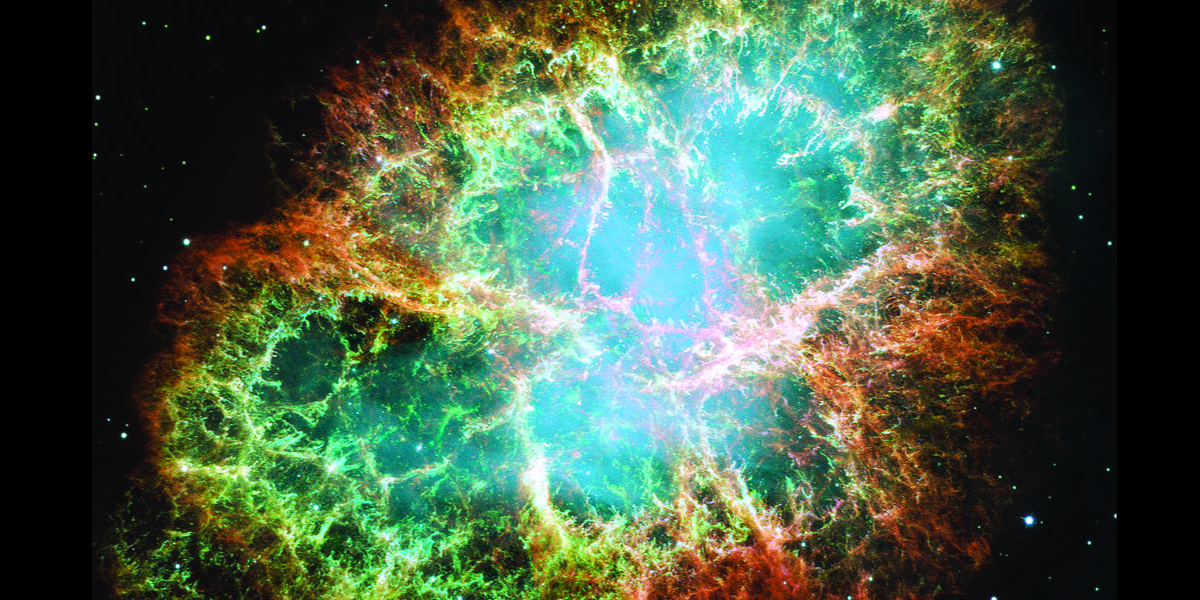 The Crab Nebula consists of remnants of a supernova (the explosion of a star). By: Rice University Openstax CC BY NC SA
The Crab Nebula consists of remnants of a supernova (the explosion of a star). By: Rice University Openstax CC BY NC SAChapter Outline
3.1 Electromagnetic Energy3.2 The Bohr Model3.3 Development of Quantum Theory3.4 Electronic Structure of Atoms (Electron Configurations)3.5 Periodic Variations in Element Properties3.6 The Periodic Table3.7 Molecular and Ionic CompoundsUpon completion of this module, you will be able to:Electromagnetic Energy (3.1)- Explain the basic behavior of waves, including traveling waves and standing waves (CLO1)(CLO3)
- Describe the wave nature of light (CLO1)(CLO3)
- Use appropriate equations to calculate related light-wave properties (CLO2)
- Distinguish between line and continuous emission spectra (CLO1)
- Describe the particle nature of light (CLO1)(CLO3)
The Bohr Model (3.2)- Describe the Bohr model of the hydrogen atom (CLO1)
- Use the Rydberg equation to calculate energies of light emitted or absorbed by hydrogen atoms (CLO2)
Development of Quantum Theory (3.3)
- Extend the concept of wave–particle duality that was observed in electromagnetic radiation to matter as well (CLO1)
- Use probabilities to explain the quantum mechanical nature of electrons in an atom (CLO1)
- List and describe traits of the four quantum numbers that form the basis for completely specifying the state of an electron in an atom (CLO1)(CLO2)
Electronic Structure of Atoms (Electron Configurations) (3.4)
- Derive the predicted ground-state electron configurations of atoms (CLO2)
- Identify and explain exceptions to predicted electron configurations for atoms and ions (CLO2)
- Relate electron configurations to element classifications in the periodic table (CLO1)
Periodic Variations in Element Properties (3.5)
- Describe and explain the observed trends in atomic size, ionization energy, and electron affinity of the elements (CLO1)
The Periodic Table (3.6)
- State the periodic law and explain the organization of elements in the periodic table (CLO1)
- Predict the general properties of elements based on their location within the periodic table (CLO1)(CLO3)
- Identify metals, nonmetals, and metalloids by their properties and/or location on the periodic table (CLO1)(CLO3)
Molecular and Ionic Compounds (3.7)
- Define ionic and molecular (covalent) compounds (CLO1)
- Predict the type of compound formed from elements based on their location within the periodic table (CLO1)(CLO3)
- Determine formulas for simple ionic compounds (CLO1)
To achieve these objectives:
- Read and view the Module 3: Chapter 3: Electronic Structure and Periodic Properties of Elements in Moodle
- Read Chapter 3: Electronic Structure and Periodic Properties of Elements in the OpenStax Chemistry: Atoms First 2e Pressbook
- Complete the Module 3: Chapter 3: Electronic Structure & Periodic Properties of Elements Assignment
- Complete the Module 3: Chapter 3: Electronic Structure & Periodic Properties of Elements Discussion
- Complete the Module 3: Lab 3: Video (VWS) Assignment - Quantum_Numbers
- Complete the Module 3: Lab 3: Experiment - E&M_Quantum_Numbers
- Complete the Module 3: Lab 3: Report - E&M_Quantum_Numbers
Note the checkboxes to the right that help you track your progress: some are automatic, and some are manual.
Module Pressbooks Resources and Activities
You will find the following resources and activities in this module at the Pressbooks website. Click on the links below to access or complete each item.
-
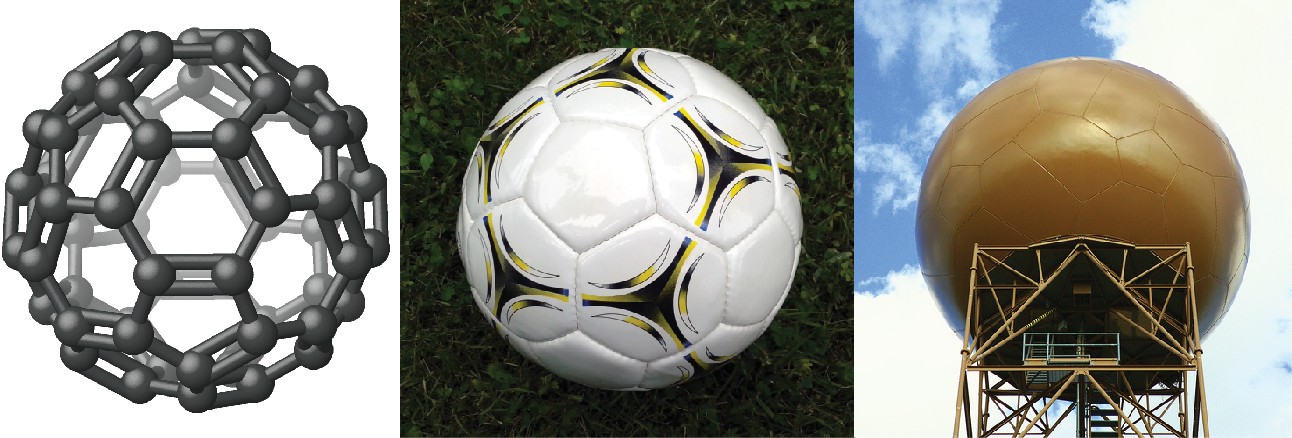
Figure 4.1 Nicknamed “buckyballs,” buckminsterfullerene molecules (C60) contain only carbon atoms (left) arranged to form a geometric framework of hexagons and pentagons, similar to the pattern on a soccer ball (center). This molecular structure is named after architect R. Buckminster Fuller, whose innovative designs combined simple geometric shapes to create large, strong structures such as this weather radar dome near Tucson, Arizona (right). By: Rice University Openstax CC BY NC SAChapter Outline
- Ionic Bonding
- Covalent Bonding
- Chemical Nomenclature
- Lewis Symbols and Structures
- Formal Charges and Resonance
- Molecular Structure and Polarity
Upon completion of this module, you will be able to:
Ionic Bonding (4.1)- Explain the formation of cations, anions, and ionic compounds (CLO1)
- Predict the charge of common metallic and nonmetallic elements, and write their electron configurations (CLO2)
Covalent Bonding (4.2)
- Describe the formation of covalent bonds (CLO1)
- Define electronegativity and assess the polarity of covalent bonds (CLO1)
Chemical Nomenclature (4.3)
- Derive names for common types of inorganic compounds using a systematic approach (CLO1)
Lewis Symbols and Structure (4.4)
- Write Lewis symbols for neutral atoms and ions (CLO2)
- Draw Lewis structures depicting the bonding in simple molecules (CLO2)
Formal Charges and Resonance (4.5)- Compute formal charges for atoms in any Lewis structure (CLO2)
- Use formal charges to identify the most reasonable Lewis structure for a given molecule (CLO1)(CLO3)
- Explain the concept of resonance and draw Lewis structures representing resonance forms for a given molecule (CLO1)
Molecular Structure and Polarity (4.6)
- Predict the structures of small molecules using valence shell electron pair repulsion (VSEPR) theory (CLO2)
- Explain the concepts of polar covalent bonds and molecular polarity (CLO1)
- Assess the polarity of a molecule based on its bonding and structure (CLO2)
To achieve these objectives:
- Read and view the Module 4: Chapter 4: Chemical Bonding and Molecular Geometry in Moodle
- Read Chapter 4: Chemical Bonding and Molecular Geometry in the OpenStax Chemistry: Atoms First 2e Pressbook
- Complete the Module 4: Chapter 4: Chemical Bonding and Molecular Geometry Assignment
- Complete the Module 4: Chapter 4: Chemical Bonding and Molecular Geometry Discussion
- Complete the Module 4: Lab 4: Video (VWS) Assignment - Drawing Lewis Diagrams
- Complete the Module 4: Lab 4: Experiment- Molecular Geometry and Polarity
- Complete the Module 4: Lab 4: Report Assignment- Molecular Geometry and Polarity
Note the checkboxes to the right that help you track your progress: some are automatic, and some are manual.
Module Pressbooks Resources and Activities
You will find the following resources and activities in this module at the Pressbooks website. Click on the links below to access or complete each item.
-
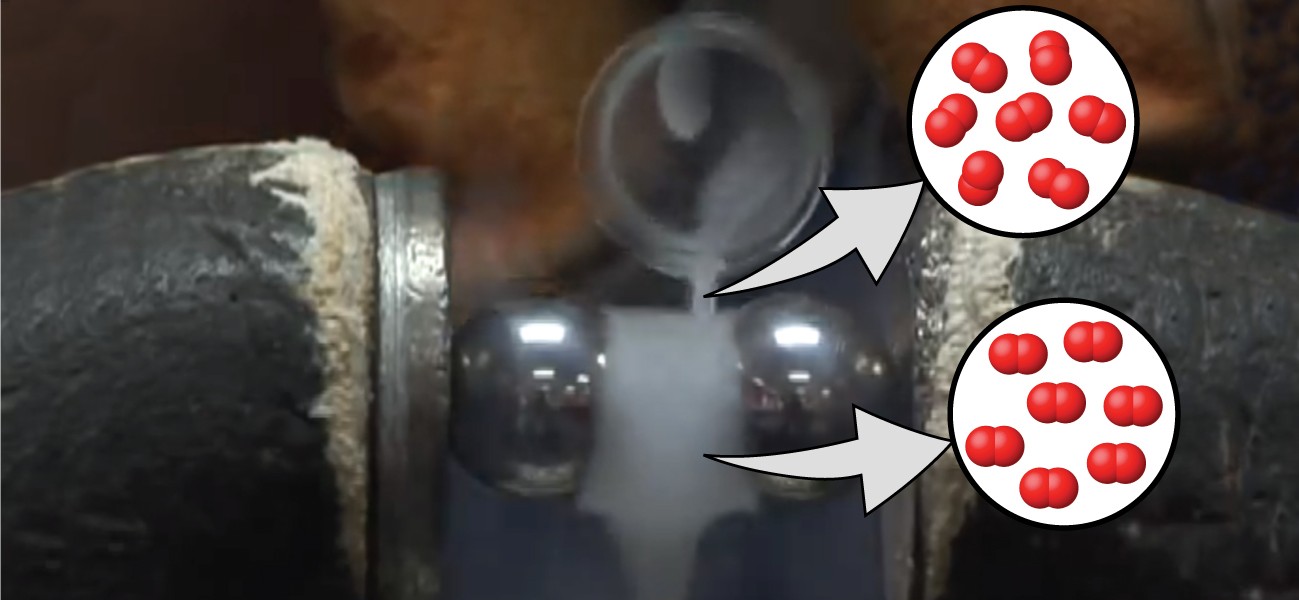
Figure 5.1 Oxygen molecules orient randomly most of the time, as shown in the top magnified view. However, when we pour liquid oxygen through a magnet, the molecules line up with the magnetic field, and the attraction allows them to stay suspended between the poles of the magnet where the magnetic field is strongest. Other diatomic molecules (like N2) flow past the magnet. The detailed explanation of bonding described in this chapter allows us to understand this phenomenon. By: Rice University Openstax CC BY NC SAChapter Outline
- Valence Bond Theory
- Hybrid Atomic Orbitals
- Multiple Bonds
- Molecular Orbital Theory
Upon completion of this module, you will be able to:
Valence Bond Theory (5.1)- Describe the formation of covalent bonds in terms of atomic orbital overlap (CLO1)
- Define and give examples of σ and π bonds (CLO1)
Hybrid Atomic Orbitals (5.2)- Explain the concept of atomic orbital hybridization (CLO1)
- Determine the hybrid orbitals associated with various molecular geometries (CLO1)
Multiple Bonds (5.3)
- Describe multiple covalent bonding in terms of atomic orbital overlap (CLO1)
- Relate the concept of resonance to π-bonding and electron delocalization (CLO1)
Molecular Orbital Theory (5.4)
- Outline the basic quantum-mechanical approach to deriving molecular orbitals from atomic orbitals (CLO1)
- Describe traits of bonding and antibonding molecular orbitals (CLO1)
- Calculate bond orders based on molecular electron configurations (CLO2)
- Write molecular electron configurations for first- and second-row diatomic molecules (CLO2)
- Relate these electron configurations to the molecules’ stabilities and magnetic properties (CLO3)
To achieve these objectives:
- Read and view the Module 5: Chapter 5: Advanced Theories of Bonding in Moodle
- Read Chapter 5: Advanced Theories of Bonding in the OpenStax Chemistry: Atoms First 2e Pressbook
- Complete the Module 5: Chapter 5: Advanced Theories of Bonding Assignment
- Complete the Module 5: Chapter 5: Advanced Theories of Bonding Discussion
- Complete the Module 5: Lab 5: Video (VWS) Assignment - Advanced Bonding
Module Pressbooks Resources and Activities
You will find the following resources and activities in this module at the Pressbooks website. Click on the links below to access or complete each item.
-
 In this module, you will take your Midterm Exam.
In this module, you will take your Midterm Exam. Read the instructions carefully and take note of any special submission guidelines.
Exam icons created by Freepik - Flaticon
Upon completion of this module, you will have:
- Read and viewed the Midterm Exam instructions
- Prepared for and submitted your Midterm Exam
To achieve these objectives:
- Read and view the contents of "Exam Information and Instructions"
- Review the Midterm Exam guidelines in your syllabus to make sure you are ready.
- Click on Midterm Exam and follow the instructions.
-

Figure 6.1 The water in a swimming pool is a complex mixture of substances whose relative amounts must be carefully maintained to ensure the health and comfort of people using the pool. (credit: modification of work by Vic Brincat) By: Rice University Openstax CC BY NC SA
Chapter Outline
- Formula Mass
- Determining Empirical and Molecular Formulas
- Molarity
- Other Units for Solution Concentrations
Upon completion of this module, you will be able to:
Formula Mass (6.1)- Calculate formula masses for covalent and ionic compounds (CLO2)
Determining Molecular and Empirical Formulas (6.2)
- Write molecular and empirical formulas (CLO1)(CLO2)
Molarity (6.3)
- Describe the fundamental properties of solutions (CLO1)
- Calculate solution concentrations using molarity (CLO2)
- Perform dilution calculations using the dilution equation (CLO2)
Other Units for Solutions Concentrations (6.4)
- Define the concentration units of mass percentage, volume percentage, mass-volume percentage, parts-per- million (ppm), and parts-per-billion (ppb) (CLO1)
- Perform computations relating a solution’s concentration and its components’ volumes and/or masses using these units (CLO2)
To achieve these objectives:
- Read and view the Module 6: Chapter 6: Composition of Substances and Solutions in Moodle
- Read Chapter 6: Composition of Substances and Solutions in the OpenStax Chemistry: Atoms First 2e Pressbook
- Complete the Module 6: Chapter 6: Composition of Substances and Solutions Assignment
- Complete the Module 6: Chapter 6: Composition of Substances and Solutions Discussion
- Complete the Module 6: Lab 6: Video (VWS) Assignment - Molarity
- Complete the Module 6: Lab 6: Experiment- Concentration and Molarity
- Complete the Module 6: Lab 6: Report Assignment - Concentration and Molarity
Module Pressbooks Resources and Activities
You will find the following resources and activities in this module at the Pressbooks website. Click on the links below to access or complete each item.
-
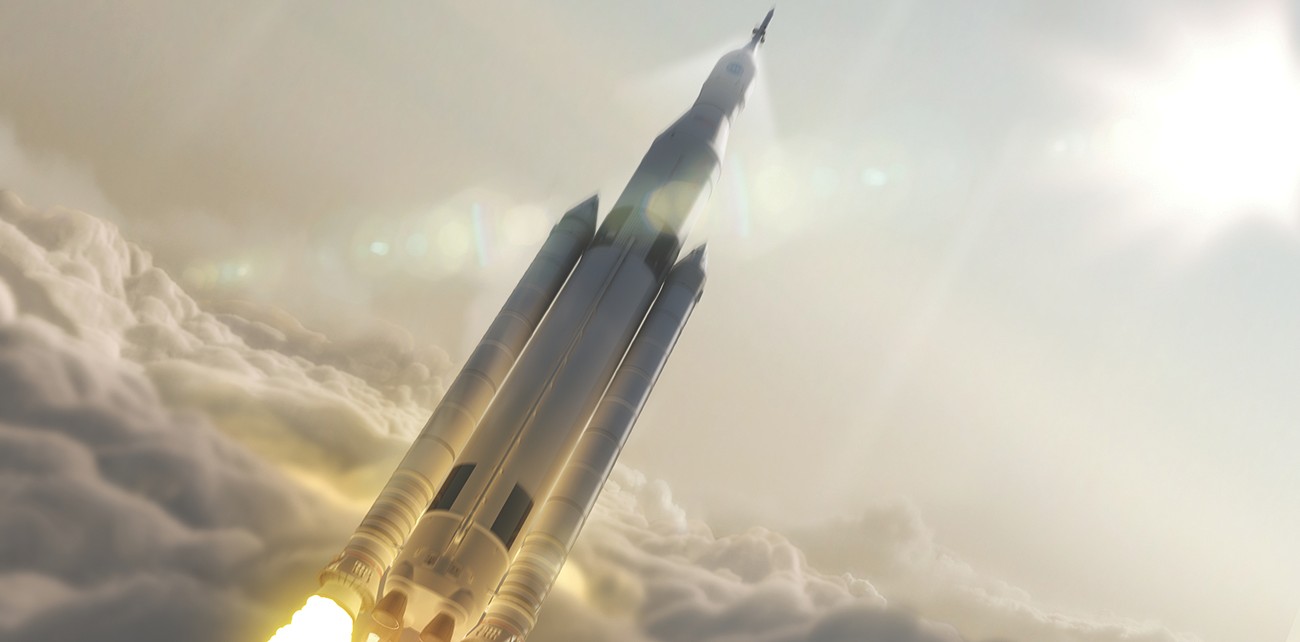
Figure 7.1 Many modern rocket fuels are solid mixtures of substances combined in carefully measured amounts and ignited to yield a thrust-generating chemical reaction. By: Rice University Openstax CC BY NC SA
Chapter Outline
- Writing and Balancing Chemical Equations
- Classifying Chemical Reactions
- Reaction Stoichiometry
- Reaction Yields
- Quantitative Chemical Analysis
Upon completion of this module, you will be able to:
Writing and Balancing Chemical Equations (7.1)
- Derive chemical equations from narrative descriptions of chemical reactions. (CLO1) (CLO2)
- Write and balance chemical equations in molecular, total ionic, and net ionic formats. (CLO2)
Classifying Chemical Reactions (7.2)
- Define three common types of chemical reactions (precipitation, acid-base, and oxidation-reduction) (CLO1)
- Classify chemical reactions as one of these three types given appropriate descriptions or chemical equations (CLO1)(CLO2)
- Classify chemical reactions as one of these three types given appropriate descriptions or chemical equations (CLO1)(CLO2)
- Identify common acids and bases (CLO1)(CLO3)
- Predict the solubility of common inorganic compounds by using solubility rules (CLO1)(CLO2)
- Compute the oxidation states for elements in compounds (CLO2)
Reaction Stoichiometry (7.3)
- Explain the concept of stoichiometry as it pertains to chemical reactions (CLO1)
- Use balanced chemical equations to derive stoichiometric factors relating to amounts of reactants and products (CLO1)(CLO2)
- Perform stoichiometric calculations involving mass, moles, and solution molarity (CLO2)
Reaction Yields (7.4)
- Explain the concepts of theoretical yield and limiting reactants/reagents. (CLO1)
- Derive the theoretical yield for a reaction under specified conditions. (CLO2)
- Calculate the percent yield for a reaction. (CLO2)
Quantitative Chemical Analysis (7.5)
- Describe the fundamental aspects of titrations and gravimetric analysis. (CLO1)
- Perform stoichiometric calculations using typical titration and gravimetric data. (CLO1)(CLO2)
To achieve these objectives:
- Read and view the Module 7: Chapter 7: Stoichiometry of Chemical Reactions in Moodle
- Read Chapter 7: Stoichiometry of Chemical Reactions in the OpenStax Chemistry: Atoms First 2e Pressbook
- Complete the Module 7: Chapter 7: Stoichiometry of Chemical ReactionsAssignment
- Complete the Module 7: Chapter 7: Stoichiometry of Chemical Reactions Discussion
- Complete the Module 7: Lab 7: Video (VWS) Assignment - Chemical Reactions
- Complete the Module 7: Lab 7: Experiment - Reactants & Products
- Complete the Module 7: Lab 7: Report Assignment - Reactants & Products
Module Pressbooks Resources and Activities
You will find the following resources and activities in this module at the Pressbooks website. Click on the links below to access or complete each item.
-
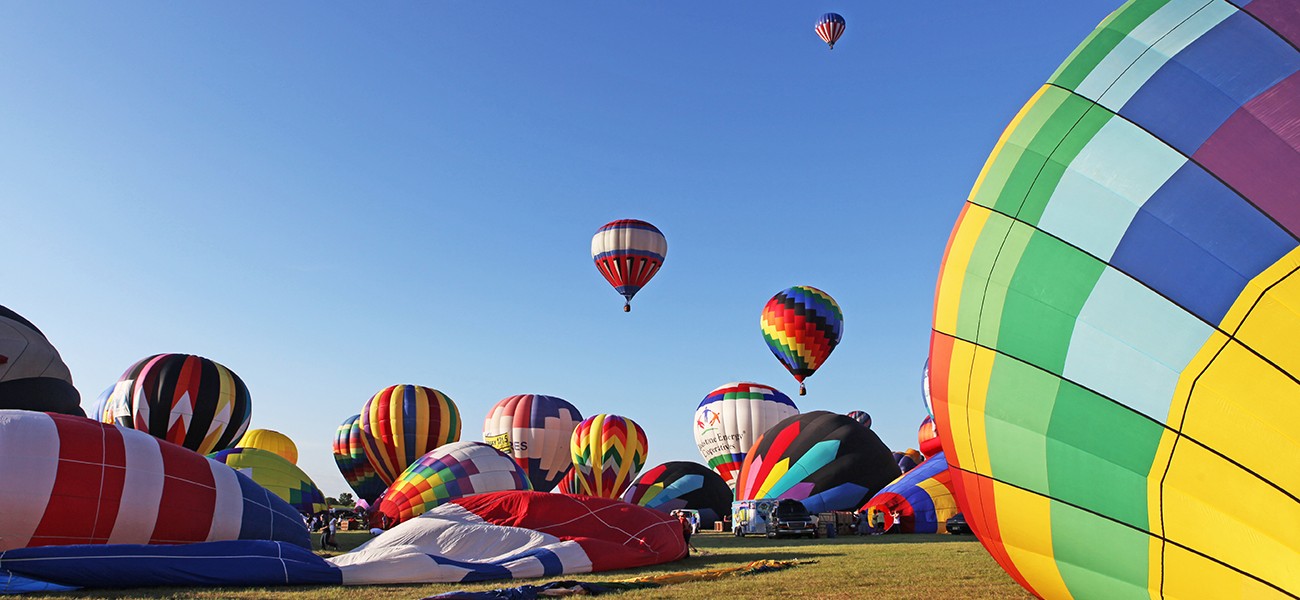
Figure 8.1 The hot air inside these balloons is less dense than the surrounding cool air. This results in a buoyant force that causes the balloons to rise when their guy lines are untied. By: Rice University Openstax CC BY NC SA
Chapter Outline
- Gas Pressure
- Relating Pressure, Volume, Amount, and Temperature: The Ideal Gas Law
- Stoichiometry of Gaseous Substances, Mixtures, and Reactions
- Effusion and Diffusion of Gases
- The Kinetic-Molecular Theory
- Non-Ideal Gas Behavior
Upon completion of this module, you will be able to:
Gas Pressure (8.1)- Define the property of pressure (CLO1)(CLO3)
- Define and convert among the units of pressure measurements (CLO1)(CLO2)
- Describe the operation of common tools for measuring gas pressure (CLO1)
- Calculate pressure from manometer data (CLO2)
Relating Pressure, Volume, Amount, and Temperature: The Ideal Gas Law (8.2)
- Identify the mathematical relationships between the various properties of gases (CLO1)(CLO2)
- Use the ideal gas law, and related gas laws, to compute the values of various gas properties under specified conditions (CLO1)(CLO2)
Stoichiometry of Gaseous Substances, Mixtures, and Reactions (8.3)- Use the ideal gas law to compute gas densities and molar masses (CLO2)
- Perform stoichiometric calculations involving gaseous substances (CLO2)
- State Dalton’s law of partial pressures and use it in calculations involving gaseous mixtures (CLO1)(CLO2)
Effusion and Diffusion of Gases (8.4)
- Define and explain effusion and diffusion (CLO1)
- State Graham’s law and use it to compute relevant gas properties (CLO1)(CLO2)
The Kinetic-Molecular Theory (8.5)
- State the postulates of the kinetic-molecular theory (CLO1)
- Use this theory’s postulates to explain the gas laws (CLO1)
Non-Ideal Gas Behavior (8.6)
- Describe the physical factors that lead to deviations from ideal gas behavior (CLO1)
- Explain how these factors are represented in the van der Waals equation (CLO1)
- Define compressibility (Z) and describe how its variation with pressure reflects non-ideal behavior (CLO1)
- Quantify non-ideal behavior by comparing computations of gas properties using the ideal gas law and the van der Waals equation (CLO1)(CLO2)
To achieve these objectives:
- Read and view the Module 8: Chapter 8: Gases in Moodle
- Read Chapter 8: Gases in the OpenStax Chemistry: Atoms First 2e Pressbook
- Complete the Module 8: Chapter 8: Gases Assignment
- Complete the Module 8: Chapter 8: Gases Discussion
- Complete the Module 8: Lab 8: Video (VWS) Assignment - Kinetic Molecular Theory of Gases
- Complete the Module 8: Lab 8: Experiment - Gas Laws
- Complete the Module 8: Lab 8: Report Assignment - Gas Laws
Module Pressbooks Resources and Activities
You will find the following resources and activities in this module at the Pressbooks website. Click on the links below to access or complete each item.
-
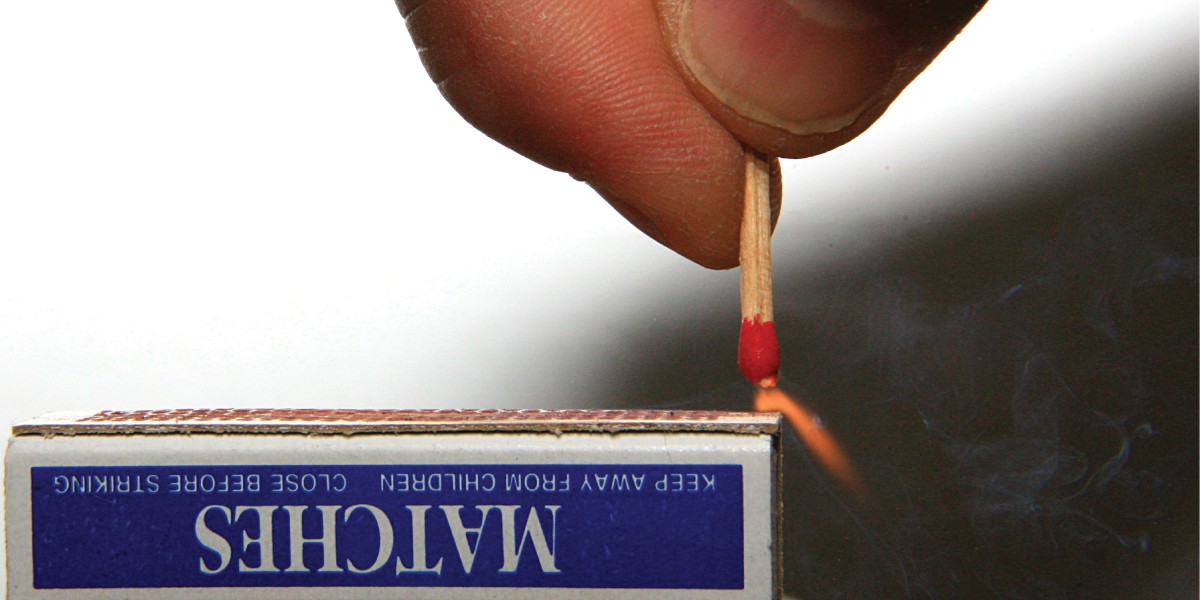
Figure 9.1 Sliding a match head along a rough surface initiates a combustion reaction that produces energy in the form of heat and light. By: Rice University Openstax CC BY NC SAChapter Outline
- Energy Basics
- Calorimetry
- Enthalpy
- Strengths of Ionic and Covalent Bonds
Upon completion of this module, you will be able to:
Energy Basics (9.1)- Define energy, distinguish types of energy, and describe the nature of energy changes that accompany chemical and physical changes (CLO1)
- Distinguish the related properties of heat, thermal energy, and temperature (CLO1)(CLO3)
- Define and distinguish specific heat and heat capacity, and describe the physical implications of both (CLO1)
- Perform calculations involving heat, specific heat, and temperature change (CLO2)
Calorimetry (9.2)
- Explain the technique of calorimetry (CLO1)
- Calculate and interpret heat and related properties using typical calorimetry data (CLO1)(CLO2)
Enthalpy (9.3)
- State the first law of thermodynamics (CLO1)
- Define enthalpy and explain its classification as a state function (CLO1)
- Write and balance thermochemical equations (CLO2)
- Calculate enthalpy changes for various chemical reactions (CLO2)
- Explain Hess’s law and use it to compute reaction enthalpies (CLO1)(CLO2)
Strengths of Ionic and Covalent Bonds (9.4)
- Describe the energetics of covalent and ionic bond formation and breakage (CLO1)
- Use the Born-Haber cycle to compute lattice energies for ionic compounds (CLO2)
- Use average covalent bond energies to estimate enthalpies of reaction (CLO2)
To achieve these objectives:
- Read and view the Module 9: Chapter 9: Thermochemistry in Moodle
- Read Chapter 9: Thermochemistry in the OpenStax Chemistry: Atoms First 2e Pressbook
- Complete the Module 9: Chapter 9: Thermochemistry Assignment
- Complete the Module 9: Chapter 9: Thermochemistry Discussion
- Complete the Module 9: Lab 9: Video (VWS) Assignment - Hess's Law
- Complete the Module 9: Lab 9: Experiment - Energy Forms and Changes
- Complete the Module 9: Lab 9: Report Assignment - Energy Forms and Changes
Module Pressbooks Resources and Activities
You will find the following resources and activities in this module at the Pressbooks website. Click on the links below to access or complete each item.
-
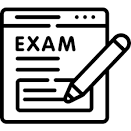 In this module, you will take your Final Exam.
In this module, you will take your Final Exam. Read the instructions carefully and take note of any special submission guidelines.
Exam icons created by Freepik - Flaticon
Upon completion of this module, you will have:
- Read and viewed the Final Exam instructions
- Prepared for and submitted your Final Exam
To achieve these objectives:
- Read and view the contents of "Exam Information and Instructions"
- Review the Final Exam guidelines in your syllabus to make sure you are ready.
- Click on Final Exam and follow the instructions.
